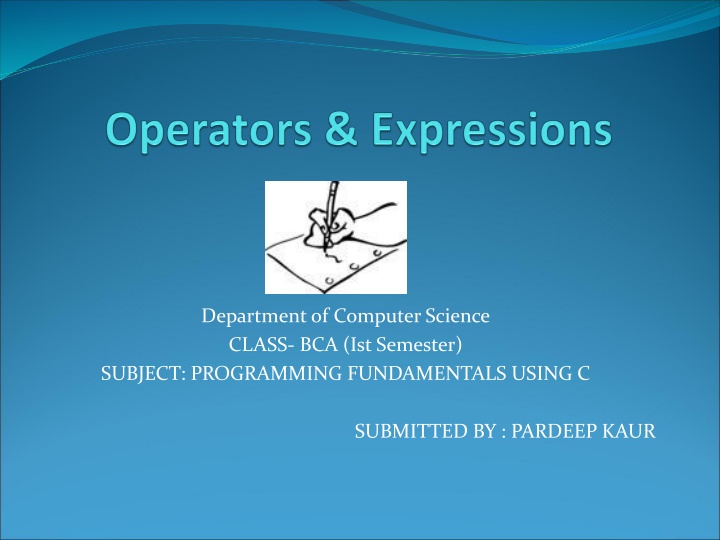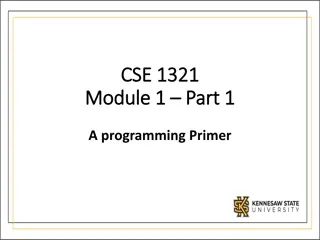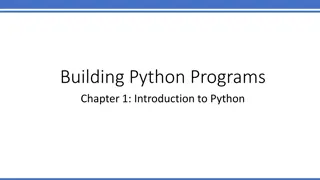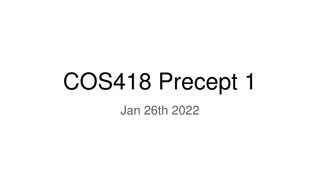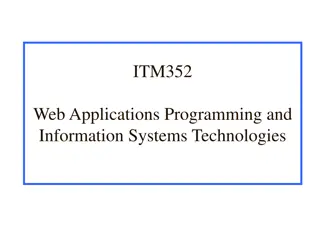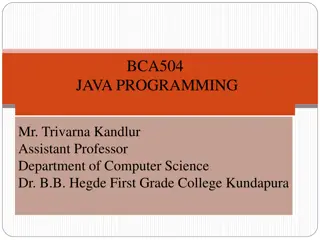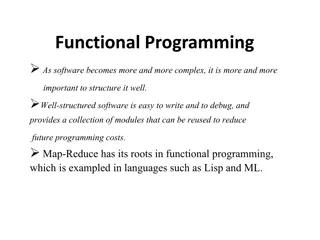Introduction to Programming Fundamentals in C
Understanding operators in C programming is essential for performing mathematical and logical operations. This content covers various types of operators such as arithmetic, relational, logical, assignment, increment, decrement, conditional, bitwise, and special operators in C. It explains their functions with examples and provides insights into truth tables, shorthand assignment operators, and increment/decrement operators. Mastering these concepts is crucial for developing efficient C programs.
Download Presentation

Please find below an Image/Link to download the presentation.
The content on the website is provided AS IS for your information and personal use only. It may not be sold, licensed, or shared on other websites without obtaining consent from the author.If you encounter any issues during the download, it is possible that the publisher has removed the file from their server.
You are allowed to download the files provided on this website for personal or commercial use, subject to the condition that they are used lawfully. All files are the property of their respective owners.
The content on the website is provided AS IS for your information and personal use only. It may not be sold, licensed, or shared on other websites without obtaining consent from the author.
E N D
Presentation Transcript
Department of Computer Science CLASS- BCA (Ist Semester) SUBJECT: PROGRAMMING FUNDAMENTALS USING C SUBMITTED BY : PARDEEP KAUR
Definition An operator is a symbol (+,-,*,/) that directs the computer to perform certain mathematical or logical manipulations and is usually used to manipulate data and variables Ex: a+b
Operators in C Arithmetic operators Relational operators Logical operators Assignment operators Increment and decrement operators Conditional operators Bitwise operators Special operators 1. 2. 3. 4. 5. 6. 7. 8.
Arithmetic operators Operator example + - * / % Meaning a + b a b a * b a / b a % b Addition unary Subtraction- unary Multiplication Division Modulo division- remainder
Relational Operators Operator < <= > >= == != Meaning Is less than Is less than or equal to Is greater than Is greater than or equal to Equal to Not equal to
Logical Operators Operator && || ! Meaning Logical AND Logical OR Logical NOT Logical expression or a compound relational expression- An expression that combines two or more relational expressions Ex: if (a==b && b==c)
Truth Table Value of the expression a && b 0 a b a || b 0 0 0 0 1 0 1 1 1 0 1 0 1 1 1
Assignment operators Syntax: v op = exp; Where v = variable, op = shorthand assignment operator exp = expression Ex: x=x+3 x+=3
Shorthand Assignment operators Simple assignment operator a = a+1 a = a-1 a = a* (m+n) a = a / (m+n) Shorthand operator a + =1 a - =1 a * = m+n a / = m+n a = a %b a %=b
Increment & Decrement Operators C supports 2 useful operators namely 1. Increment ++ 2. Decrement operators The ++ operator adds a value 1 to the operand The operator subtracts 1 from the operand ++a or a++ --a or a--
Rules for ++ & -- operators 1. These require variables as their operands 2. When postfix either ++ or is used with the variable in a given expression, the expression is evaluated first and then it is incremented or decremented by one 3. When prefix either ++ or is used with the variable in a given expression, it is incremented or decremented by one first and then the expression is evaluated with the new value
Examples for ++ & -- operators Let the value of a =5 and b=++a then a = b =6 Let the value of a = 5 and b=a++ then a =5 but b=6 i.e.: 1. a prefix operator first adds 1 to the operand and then the result is assigned to the variable on the left 2. a postfix operator first assigns the value to the variable on left and then increments the operand.
Conditional operators Syntax: exp1 ? exp2 : exp3 Where exp1,exp2 and exp3 are expressions Working of the ? Operator: Exp1 is evaluated first, if it is nonzero(1/true) then the expression2 is evaluated and this becomes the value of the expression, If exp1 is false(0/zero) exp3 is evaluated and its value becomes the value of the expression Ex: m=2; n=3 r=(m>n) ? m : n;
Bitwise operators These operators allow manipulation of data at the bit level Operator & | ^ << >> Meaning Bitwise AND Bitwise OR Bitwise exclusive OR Shift left Shift right
Special operators Comma operator ( ,) sizeof operator sizeof( ) Pointer operators ( & and *) Member selection operators ( . and ->) 1. 2. 3. 4.
Arithmetic Expressions Algebraic expression C expression axb-c a*b-c (m+n)(x+y) (m+n)*(x+y) a*b/c ab c 3x2+2x+1 3*x*x+2*x+1 a/b a b S=(a+b+c)/2 + + a b c S= 2
Arithmetic Expressions Algebraic expression C expression area= area=sqrt(s*(s-a)*(s-b)*(s-c)) ( )( )( ) s s a s b s c sin(b/sqrt(a*a+b*b)) b Sin + 2 2 a b tow1=sqrt((rowx-rowy)/2+tow*x*y*y) x y = + 2 xy 1 2 tow1=sqrt(pow((rowx-rowy)/2,2)+tow*x*y*y) 2 x y = + 2 xy 1 2 sin + y=(alpha+beta)/sin(theta*3.1416/180)+abs(x) = + y x
Precedence of operators BODMAS RULE- Brackets of Division Multiplication Addition Subtraction Brackets will have the highest precedence and have to be evaluated first, then comes of , then comes division, multiplication, addition and finally subtraction. C language uses some rules in evaluating the expressions and they r called as precedence rules or sometimes also referred to as hierarchy of operations, with some operators with highest precedence and some with least. The 2 distinct priority levels of arithmetic operators in c are- Highest priority : * / % Lowest priority : + -
Rules for evaluation of expression First parenthesized sub expression from left to right are evaluated. If parentheses are nested, the evaluation begins with the innermost sub expression The precedence rule is applied in determining the order of application of operators in evaluating sub expressions The associatively rule is applied when 2 or more operators of the same precedence level appear in a sub expression. Arithmetic expressions are evaluated from left to right using the rules of precedence When parentheses are used, the expressions within parentheses assume highest priority 1. 2. 3. 4. 5. 6.
Hierarchy of operators Operator ( ), [ ] Description Function call, array element reference Unary plus, minus, increment, decrement, logical negation, 1 s complement, pointer reference, address Multiplication, division, modulus Associativity Left to Right +, -, ++, - - ,!,~,*,& Right to Left *, / , % Left to Right
Example 1 Evaluate x1=(-b+ sqrt (b*b-4*a*c))/(2*a) @ a=1, b=-5, c=6 =(-(-5)+sqrt((-5)(-5)-4*1*6))/(2*1) =(5 + sqrt((-5)(-5)-4*1*6))/(2*1) =(5 + sqrt(25 -4*1*6))/(2*1) =(5 + sqrt(25 -4*6))/(2*1) =(5 + sqrt(25 -24))/(2*1) =(5 + sqrt(1))/(2*1) =(5 + 1.0)/(2*1) =(6.0)/(2*1) =6.0/2 = 3.0
Example 2 Evaluate the expression when a=4 b=a- ++a =a 5 =5-5 =0
